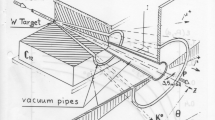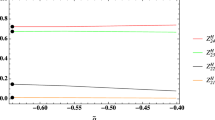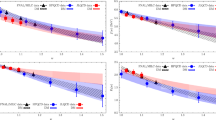Abstract
The isospin breaking and radiative decay widths of the positive-parity charm-strange mesons, \(D^{*}_{s0}\) and \(D_{s1}\), and their predicted bottom-strange counterparts, \(B^{*}_{s0}\) and \(B_{s1}\), as hadronic molecules are revisited. This is necessary, since the \(B^{*}_{s0}\) and \(B_{s1}\) masses used in (Cleven et al., Eur Phys J A 50:149, 2014) were too small, in conflict with the heavy quark flavour symmetry. Furthermore, not all isospin breaking contributions were considered. We here present a method to restore heavy quark flavour symmetry, correcting the masses of \(B^{*}_{s0}\) and \(B_{s1}\), and include the complete isospin breaking contributions up to next-to-leading order. With this we provide updated hadronic decay widths for all of \(D^{*}_{s0}\), \(D_{s1}\), \(B^{*}_{s0}\) and \(B_{s1}\). Results for the partial widths of the radiative deays of \(D_{s0}^*(2317)\) and \(D_{s1}(2460)\) are also renewed in light of the much more precisely measured \(D^{*+}\) width. We find that \(B_s\pi ^0\) and \(B_s\gamma \) are the preferred channels for searching for \(B_{s0}^*\) and \(B_{s1}\), respectively.


Similar content being viewed by others
Data Availability Statement
This manuscript has no associated data or the data will not be deposited. [Authors’ comment: This is a theoretical study and has no associated data.]
Notes
The error quoted here is smaller than that in Ref. [1] as there was a typo in the code for the \(\pi ^0\mathrm{-}\eta \) mixing used therein.
References
M. Cleven, H.W. Grießhammer, F.-K. Guo, C. Hanhart, U.-G. Meißner, Eur. Phys. J. A 50, 149 (2014). [arXiv:1405.2242 [hep-ph]]
B. Aubert et al., BaBar. Phys. Rev. Lett. 90, 242001 (2003). [arXiv:hep-ex/0304021 [hep-ex]]
D. Besson et al. [CLEO], Phys. Rev. D 68 (2003) 032002 [erratum: Phys. Rev. D 75 (2007) 119908] [arXiv:hep-ex/0305100 [hep-ex]]
F.-K. Guo, C. Hanhart, U.-G. Meißner, Q. Wang, Q. Zhao, B.-S. Zou, Rev. Mod. Phys. 90, 015004 (2018). [arXiv:1705.00141 [hep-ph]]
M.A. Nowak, M. Rho, I. Zahed, Acta Phys. Polon. B 35, 2377 (2004). [arXiv:hep-ph/0307102 [hep-ph]]
W.A. Bardeen, E.J. Eichten, C.T. Hill, Phys. Rev. D 68, 054024 (2003). [arXiv:hep-ph/0305049 [hep-ph]]
N.N. Achasov, S.A. Devyanin, G.N. Shestakov, Phys. Lett. B 88, 367 (1979)
C. Hanhart, B. Kubis, J.R. Pelaez, Phys. Rev. D 76, 074028 (2007). [arXiv:0707.0262 [hep-ph]]
M. Albaladejo, P. Fernandez-Soler, F.-K. Guo, J. Nieves, Phys. Lett. B 767, 465 (2017). [arXiv:1610.06727 [hep-ph]]
M.-L. Du, M. Albaladejo, P. Fernández-Soler, F.-K. Guo, C. Hanhart, U.-G. Meißner, J. Nieves, D.L. Yao, Phys. Rev. D 98, 094018 (2018). [arXiv:1712.07957 [hep-ph]]
F.-K. Guo, P.-N. Shen, H.-C. Chiang, R.G. Ping, B.S. Zou, Phys. Lett. B 641, 278 (2006). [arXiv:hep-ph/0603072 [hep-ph]]
F.-K. Guo, P.-N. Shen, H.-C. Chiang, Phys. Lett. B 647, 133 (2007). [arXiv:hep-ph/0610008 [hep-ph]]
E.E. Kolomeitsev, M.F.M. Lutz, Phys. Lett. B 582, 39 (2004). [arXiv:hep-ph/0307133 [hep-ph]]
C.B. Lang, D. Mohler, S. Prelovsek, R.M. Woloshyn, Phys. Lett. B 750, 17 (2015). [arXiv:1501.01646 [hep-lat]]
A. Faessler, T. Gutsche, V.E. Lyubovitskij, Y.L. Ma, Phys. Rev. D 76, 014005 (2007). [arXiv:0705.0254 [hep-ph]]
D. Gamermann, L.R. Dai, E. Oset, Phys. Rev. C 76, 055205 (2007). [arXiv:0709.2339 [hep-ph]]
A. Faessler, T. Gutsche, V.E. Lyubovitskij, Y.L. Ma, Phys. Rev. D 76, 114008 (2007). [arXiv:0709.3946 [hep-ph]]
M.F.M. Lutz, M. Soyeur, Nucl. Phys. A 813, 14 (2008). [arXiv:0710.1545 [hep-ph]]
A. Faessler, T. Gutsche, V.E. Lyubovitskij, Y.-L. Ma, Phys. Rev. D 77, 114013 (2008). [arXiv:0801.2232 [hep-ph]]
F.-K. Guo, C. Hanhart, S. Krewald, U.-G. Meißner, Phys. Lett. B 666, 251 (2008). [arXiv:0806.3374 [hep-ph]]
C.-J. Xiao, D.Y. Chen, Y.-L. Ma, Phys. Rev. D 93, 094011 (2016). [arXiv:1601.06399 [hep-ph]]
X.-Y. Guo, Y. Heo, M.F.M. Lutz, Phys. Rev. D 98, 014510 (2018). [arXiv:1801.10122 [hep-lat]]
S. Fajfer and A. Prapotnik Brdnik, Phys. Rev. D 92 (2015) 074047 [arXiv:1506.02716 [hep-ph]]
S. Fajfer and A. Prapotnik Brdnik, Eur. Phys. J. C 76 (2016) 537 [arXiv:1606.06943 [hep-ph]]
M.H. Alhakami, Phys. Rev. D 103, 034009 (2021). [arXiv:2006.16878 [hep-ph]]
L. Liu, K. Orginos, F.-K. Guo, C. Hanhart, U.-G. Meißner, Phys. Rev. D 87, 014508 (2013). [arXiv:1208.4535 [hep-lat]]
J.A. Oller, U.-G. Meißner, Phys. Lett. B 500, 263 (2001). [arXiv:hep-ph/0011146 [hep-ph]]
M. Cleven, F.-K. Guo, C. Hanhart, U.-G. Meißner, Eur. Phys. J. A 47, 19 (2011). [arXiv:1009.3804 [hep-ph]]
M. Albaladejo, P. Fernandez-Soler, J. Nieves, P.G. Ortega, Eur. Phys. J. C 77, 170 (2017). [arXiv:1612.07782 [hep-ph]]
P. A. Zyla et al. [Particle Data Group], PTEP 2020 (2020) 083C01 and the 2021 update
J. Hu, T. Mehen, Phys. Rev. D 73, 054003 (2006). [arXiv:hep-ph/0511321 [hep-ph]]
M. Ablikim et al., BESIII. Phys. Rev. D 97, 051103 (2018). [arXiv:1711.08293 [hep-ex]]
G.K.C. Cheung et al., Hadron Spectrum. JHEP 02, 100 (2021). [arXiv:2008.06432 [hep-lat]]
S. Weinberg, Phys. Rev. 137, B672 (1965)
A. Martínez Torres, E. Oset, S. Prelovsek and A. Ramos, JHEP 05 (2015) 153 [arXiv:1412.1706 [hep-lat]]
M. Albaladejo, D. Jido, J. Nieves and E. Oset, \(D^*_{s0}(2317)\) and \(DK\) scattering in B decays from BaBar and LHCb data. Eur. Phys. J. C 76, 300 (2016). https://doi.org/10.1140/epjc/s10052-016-4144-3. [arXiv:1604.01193 [hep-ph]]
G.S. Bali, S. Collins, A. Cox, A. Schäfer, Phys. Rev. D 96, 074501 (2017). [arXiv:1706.01247 [hep-lat]]
Y. Li, F.-K. Guo, J.-Y. Pang and J.-J. Wu, [arXiv:2110.02766 [hep-ph]]
C. Hanhart, Y.S. Kalashnikova, A.E. Kudryavtsev, A.V. Nefediev, Phys. Rev. D 75, 074015 (2007). [arXiv:hep-ph/0701214 [hep-ph]]
Acknowledgements
This work is supported in part by the National Natural Science Foundation of China (NSFC) and the Deutsche Forschungsgemeinschaft (DFG, German Research Foundation) through the funds provided to the Sino-German Collaborative Research Center “Symmetries and the Emergence of Structure in QCD” (NSFC Grant No. 12070131001, DFG Project-ID 196253076 – TRR110), by NSFC under Grants No. 11835015, No. 12047503, No. 11961141012 and No. 12125507, by the Chinese Academy of Sciences (CAS) under Grants No. XDPB15, No. XDB34030000 and No. QYZDB-SSW-SYS013, by CAS through a President’s International Fellowship Initiative (PIFI) (Grant No. 2018DM0034), by the VolkswagenStiftung (Grant No. 93562), by the EU Horizon 2020 research and innovation programme, STRONG-2020 project under grant agreement No 824093, and by the US Department of Energy under contract DE-SC0015393.
Author information
Authors and Affiliations
Corresponding author
Additional information
Communicated by Laura Tolos.
Appendix
Appendix
For reference, in this appendix we provide the numerical results of the values of the S-wave scattering lengths \(a_0\) and effective ranges \(r_{0}\) for the charm-light and bottom-light meson scattering. We use the following convention for the effective range expansion of the S-wave amplitude:
where \(\sqrt{s}\) and k are the total energy and the size of three-momentum in the center-of-mass frame, respectively. In particular, the effective range, for which we only show the values for those with the lowest threshold in each coupled-channel system, predictions have been not been presented before. The results are shown in Table 6. The \(B_s\pi \) and \(D_s\pi \) effective ranges, \(-1284_{-1336}^{+446}\,\)fm and \(201_{-270}^{+100}\,\)fm, respectively, are not listed in the table since they are unreliable. The reason is that the leading order chiral amplitudes for these elastic scattering vanish and they receive contributions only from higher orders; consequently the amplitude has a zero close to threshold from higher orders, to which the effective range is sensitive.
Not all of the values for the charm-light scattering lengths completely agree with those given in Ref. [26]. The reason is that in Ref. [26], the charmed mesons and kaons are heavier than their physical masses when extrapolated to the physical pion mass, \(M_D^\text {lat.}\simeq 1947\) MeV and \(M_K^\text {lat.}\simeq 560\) MeV. Here, we use the physical masses for all mesons instead. The large values of the scattering lengths for the isoscalar \(D\bar{K}\) and \(\bar{B} \bar{K}\) are due to the near-threshold virtual states predicted in Ref. [9], which are about 20 MeV below the \(D\bar{K}\) threshold and almost at the \(\bar{B} \bar{K}\) threshold, respectively. Thus, the systems are fine tuned, and it is this difference that also makes the effective ranges of these two channels have opposite signs. The existence of an isoscalar \(D\bar{K}\) virtual state received support from lattice QCD calculations in Ref. [33].
Using Weinberg’s expressions to relate the scattering length and effective range to the probability of finding the two-hadron component in the physical wave function of a state, the so-called compositeness \(1-Z\) [34],
where \(\gamma =\sqrt{2 \mu \epsilon }\) is the binding momentum, with \(\epsilon \) the binding energy and \(\mu \) the reduced mass, we find that the compositeness for the pole in the isoscalar \(\bar{B}^{(*)} K\) system,
is in the same ballpark as that of the \(D_{s0}^*\) found in Refs. [26, 33, 35,36,37]. Here, the first uncertainty is propagated from those of the parameters and the second one is an additional intrinsic uncertainty in the above relations. It is usually estimated as \(\mathcal {O}(\gamma /\beta )\), where \(\beta \) is a hard scale set by the neglected heavier degrees of freedom, since Ref. [34] used a constant form factor approximation for the coupling of the composite system to its constituents. However, as shown in Ref. [38], in case of a negative effective range, as is the case here, the above relations hold even when the constant form factor approximation is lifted. Consequently, the intrinsic uncertainty should be \(\mathcal {O}(\gamma ^2/\beta ^2)\); see also Ref. [39]. With \(\beta \sim m_\rho \), and \(\gamma \approx 0.2\) GeV, one has \(\gamma ^2/\beta ^2\approx 0.07\).
Rights and permissions
About this article
Cite this article
Fu, HL., Grießhammer, H.W., Guo, FK. et al. Update on strong and radiative decays of the \(D_{s0}^*(2317)\) and \(D_{s1}(2460)\) and their bottom cousins. Eur. Phys. J. A 58, 70 (2022). https://doi.org/10.1140/epja/s10050-022-00724-8
Received:
Accepted:
Published:
DOI: https://doi.org/10.1140/epja/s10050-022-00724-8




